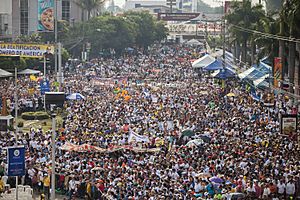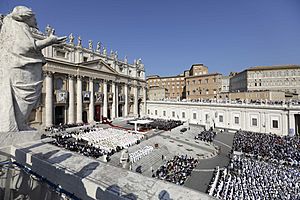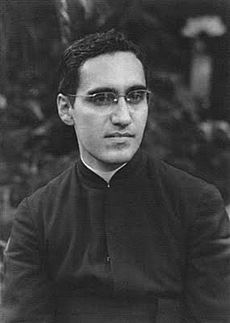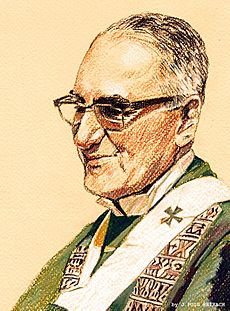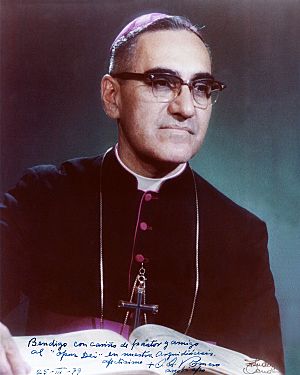Óscar Romero facts for kids
Quick facts for kids Óscar Romero |
|
|---|---|
| Archbishop of San Salvador | |
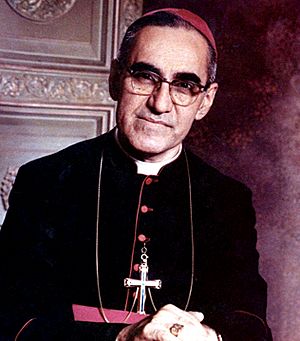
Romero in 1978 on a visit to Rome
|
|
| Church | Catholic Church |
| Archdiocese | San Salvador |
| Appointed | 3 February 1977 |
| Enthroned | 22 February 1977 |
| Reign ended | 24 March 1980 |
| Predecessor | Luis Chávez y González |
| Successor | Arturo Rivera y Damas |
| Other posts |
|
| Orders | |
| Ordination | 4 April 1942 |
| Consecration | 25 April 1970 by Girolamo Prigione |
| Personal details | |
| Birth name | Óscar Arnulfo Romero y Galdámez |
| Born | 15 August 1917 Ciudad Barrios, San Miguel, El Salvador |
| Died | 24 March 1980 (aged 62) Chapel of Hospital de la Divina Providencia, San Salvador, El Salvador |
| Buried | Metropolitan Cathedral of San Salvador, San Salvador |
| Denomination | Catholicism |
| Signature | |
| Coat of arms | |
| Sainthood | |
| Feast day | 24 March |
| Venerated in |
|
| Beatified | 23 May 2015 Plaza El Salvador de Mundo, San Salvador, El Salvador by Angelo Amato, representing Pope Francis |
| Canonized | 14 October 2018 Saint Peter's Square, Vatican City by Pope Francis |
| Attributes | Episcopal vestments Crown of martyrdom Martyr's palm Rosary |
| Patronage |
|
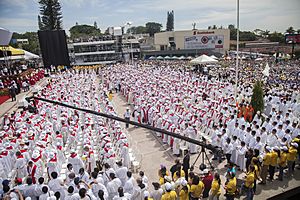
Óscar Arnulfo Romero y Galdámez (born August 15, 1917 – died March 24, 1980) was a Catholic leader in El Salvador. He became known for speaking out against unfairness and violence. This was during a time of growing conflict between the government and rebel groups, which led to the Salvadoran Civil War.
Romero was killed in 1980 while leading a church service. Even though no one was officially found guilty, investigations suggested that a military leader named Roberto D'Aubuisson ordered the killing.
In 1997, Pope John Paul II began the process to recognize Romero as a saint. Pope Francis declared him a martyr (someone who dies for their beliefs) in 2015. This led to Romero being declared "blessed" on May 23, 2015. Pope Francis said Romero's work was special because he cared deeply for the poor and those who were left out. Romero was made a saint on October 14, 2018.
At first, Romero was seen as a traditional leader. But after his friend, a priest named Rutilio Grande, was killed, Romero became a strong critic of the military government in El Salvador. He supported the Catholic Church's teachings on helping the poor and wanted a peaceful change in society.
In 2010, the United Nations General Assembly named March 24 as the "International Day for the Right to the Truth Concerning Gross Human Rights Violations and for the Dignity of Victims." This day honors Romero's efforts to protect human rights. He often spoke against violence and for the dignity of all people.
Many people in Latin America see Romero as a special protector of the Americas and El Salvador. Catholics in El Salvador often call him San Romero, which means Saint Romero. Other Christian groups also honor him. He is one of ten 20th-century martyrs honored at Westminster Abbey in London.
Contents
Early Life and Education
Óscar Romero was born on August 15, 1917. His parents were Santos Romero and Guadalupe de Jesús Galdámez. He was born in Ciudad Barrios in El Salvador. He was baptized into the Catholic Church when he was one year old.
Romero went to a local public school for a few years. After that, a private teacher helped him learn until he was thirteen. During this time, his father taught him carpentry. Romero was very good at it. Even though his father wanted him to learn a trade, Romero decided he wanted to study to become a priest. This did not surprise those who knew him.
Becoming a Priest
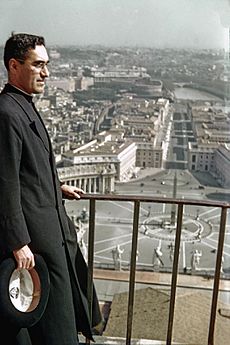
Romero started studying at a seminary in San Miguel when he was thirteen. He later went to a national seminary in San Salvador. He finished his studies at the Gregorian University in Rome, Italy. He earned a special degree in theology in 1941. He had to wait a year to become a priest because he was too young.
He was made a priest in Rome on April 4, 1942. His family could not attend because of travel rules during World War II. Romero stayed in Italy to study more about theology. In 1943, his bishop asked him to return home to El Salvador. On his way back, he and a friend were held by police in Cuba. They were later released and traveled through Mexico to reach El Salvador.
Romero first worked as a local priest in Anamorós. Then he moved to San Miguel, where he worked for over 20 years. He helped start many church groups. He also helped build San Miguel's cathedral. Later, he became the head of a seminary in San Salvador. He also became the editor of the archdiocese's newspaper, Orientación.
Bishop and Archbishop

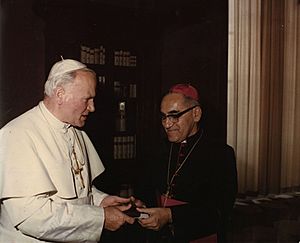
On April 25, 1970, Romero became an auxiliary bishop for the Archdiocese of San Salvador. He was then appointed Bishop of the Diocese of Santiago de María in 1974. This was a poor, rural area.
On February 3, 1977, Romero was chosen to be the Archbishop of San Salvador. He officially started this important role on February 22.
In 1979, a new government group came to power in El Salvador. There were many reports of human rights abuses by military groups. This led to the Salvadoran Civil War. Romero spoke against the United States giving military help to this new government. In February 1980, he wrote a letter to President Jimmy Carter. He warned that more military aid would "sharpen the injustice and the political repression." This meant it would make things worse for people fighting for their basic rights.
Romero also met with Pope John Paul II in 1979. He tried to get the Vatican to speak out against the Salvadoran military government. He was worried about human rights violations. The Pope encouraged him to keep the church united.
Romero became known around the world for his efforts to help people. In February 1980, he received an honorary doctorate from the Catholic University of Louvain.
His Death
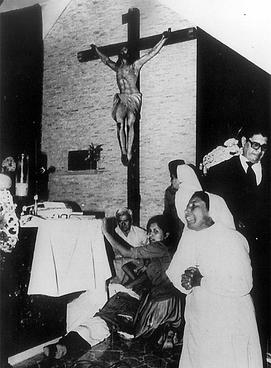
On March 23, 1980, Archbishop Romero gave a sermon. He asked Salvadoran soldiers, as Christians, to follow God's commands. He told them to stop harming people and violating basic human rights.
On March 24, Romero was leading a Mass at a small chapel. This chapel was part of a hospital in San Salvador. As he finished his sermon and stood at the altar, a car stopped outside. A gunman got out, came to the chapel door, and fired shots. Romero was hit in the heart and died there.
Funeral and Impact
Romero was buried in the Metropolitan Cathedral of San Salvador. His funeral was held on March 30, 1980. More than 250,000 people from all over the world attended. Many saw this large gathering as a protest against the violence.
At the funeral, Cardinal Ernesto Corripio y Ahumada spoke for Pope John Paul II. He called Romero a "beloved, peacemaking man of God." He said that Romero's death would bring "brotherhood, love and peace."
His Lasting Impact
In 1983, Pope John Paul II visited El Salvador. He prayed at Romero's tomb in the cathedral. This was despite some people in the government and church not wanting him to. The Pope praised Romero as a "zealous and venerated pastor who tried to stop violence." He also asked for peace talks to end El Salvador's civil war.
On December 21, 2010, the United Nations recognized March 24. They named it the International Day for the Right to the Truth. This day honors Romero's important work and values.
Many important people have visited Romero's tomb. These include U.S. President Barack Obama in 2011 and Irish President Michael D. Higgins in 2013. In 2014, El Salvador's main international airport was named after him. It is now called San Óscar Arnulfo Romero y Galdámez International Airport.
Romero is remembered and honored by different Christian churches. This includes the Church of England and the Episcopal Church on March 24.
See also
 In Spanish: Óscar Arnulfo Romero para niños
In Spanish: Óscar Arnulfo Romero para niños
- List of peace activists
- List of unsolved murders
- Misa Campesina Nicaragüense
- Stanley Rother
- Salvadoran Civil War
- Rutilio Grande: assassinated 12 March 1977
- Alfonso Navarro: assassinated 11 May 1977
- Ernesto Barrera: assassinated 28 November 1978
- Octavio Ortiz: assassinated 20 January 1979
- Rafael Palacios: assassinated 20 June 1979
- Napoleón Macías: assassinated 4 August 1979
- Ignacio Martín-Baró: assassinated 16 November 1989
- Segundo Montes: assassinated 16 November 1989
- Ignacio Ellacuría: assassinated 16 November 1989
- Maura Clarke, Maryknoll
- Jean Donovan, lay missionary
- Ita Ford, Maryknoll
- Dorothy Kazel, Ursuline nun


